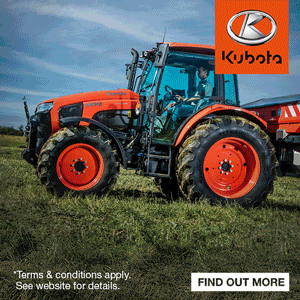SsangYong Musso pick-ups are gaining a strong reputation among the farming community, as recent versions combine good build quality with comfort and great load carrying capability. Farmers Guide‘s David Williams tried the latest version.
There are four equipment levels to choose from, including the base EX, mid-specification Rebel, and the flagship Saracen with a standard length load bed or the Saracen+ with a slightly longer load area. All share the same 2.2-litre diesel engine, and the EX comes only with a six-speed manual transmission, whereas a six-speed automatic is standard for all other models. The version supplied for the Farmers Guide week-long test was the Saracen, with a standard load bed.
Latest models introduced have more power and torque than their predecessors and the manufacturer also claims improved fuel economy, as well as reduced emissions. The new models boast upgraded suspension and a revised interior for greater comfort and an improved driver and passenger experience.
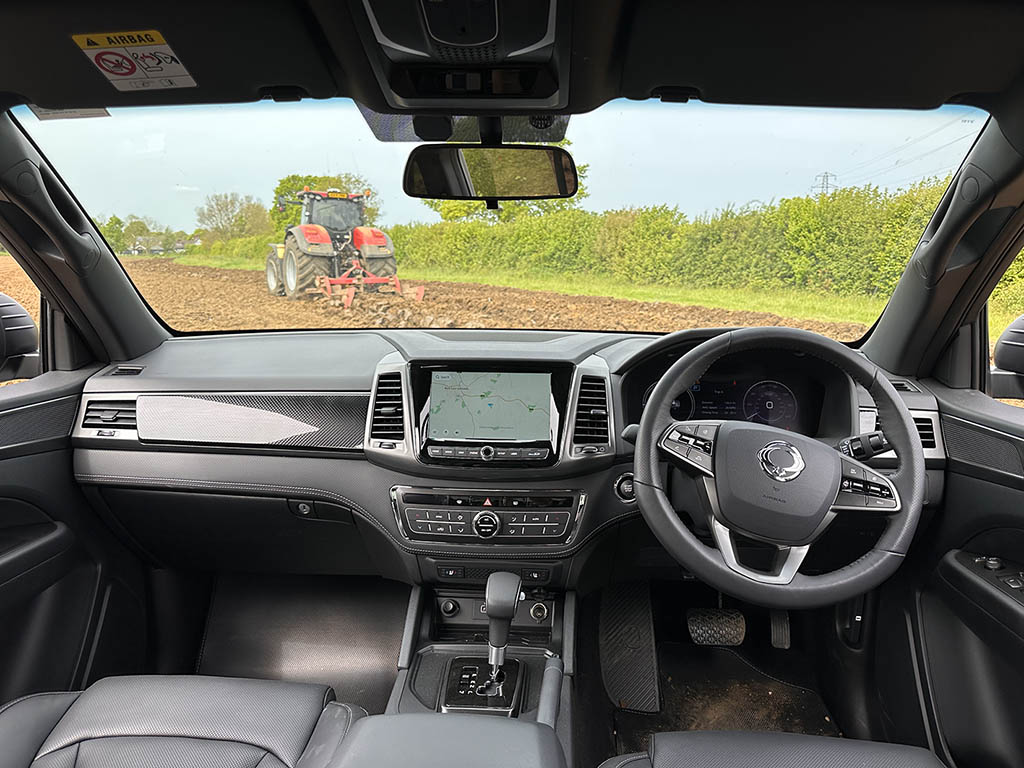
The Saracen has a generous equipment specification, including nappa leather seats.
Interiors
The large seats are comfortable for long journeys and practical for farm use as they are easily wiped clean. The front seats have electric position controls and are heated and cooled. The rear seats are heated. There is plenty of legroom in the front, and the amount of rear space is reasonable – even with the front seats right back, allowing four adults to travel in comfort. The climate control works well, and there is plenty of air conditioning capacity to keep the accommodation cool on hot days. The rear seat passengers have their own air vents integrated within the rear centre console.
Storage options include large pockets in all four doors, a large lockable glovebox and a generous size box in the centre console. There are also drinks holders and handy trays near the gear selector, and a tray on top of the dashboard.
The Saracen comes with a 9.2-in touchscreen which displays images from the rear-view camera and provides navigation and infotainment. Apple CarPlay and Android Auto compatibility is standard.
The main gear selector has fully automatic and manual override selection modes, and for manual operation a small toggle switch at the top of the selector lever makes the changes.
A rotary dial behind the gear lever selects 2wd or 4wd and high or low range. Additional driver assistance is provided by hill start assist and hill descent control. Unusually for a modern pick-up, the Musso has a traditional mechanical handbrake in the centre.
The finish quality is very good and farmers who viewed the pick-up during the test drive week were genuinely impressed.

The load bed is one of the largest in its class, and SsangYong claims the highest legal combined load bed and trailer towing capacity with a maximum gross train weight of 6,750kg.
Practicality
SsangYong claims that the Musso is the only pick-up legally able to tow a 3.5t trailer and carry a one-tonne payload simultaneously. Trailer sway control is standard, adding confidence for those utilising the towing capacity. The test vehicle had a load liner fitted, plus a roll cover. The usable load bed was 130cm long, had a maximum width of 159cm and 115cm between the wheel arches. The tailgate opening is 137cm wide. The roll cover is practical and secure but restricts the space for larger items. Fully retracted, the opening is 94cm long and 140cm wide. There are four internal tie down points.
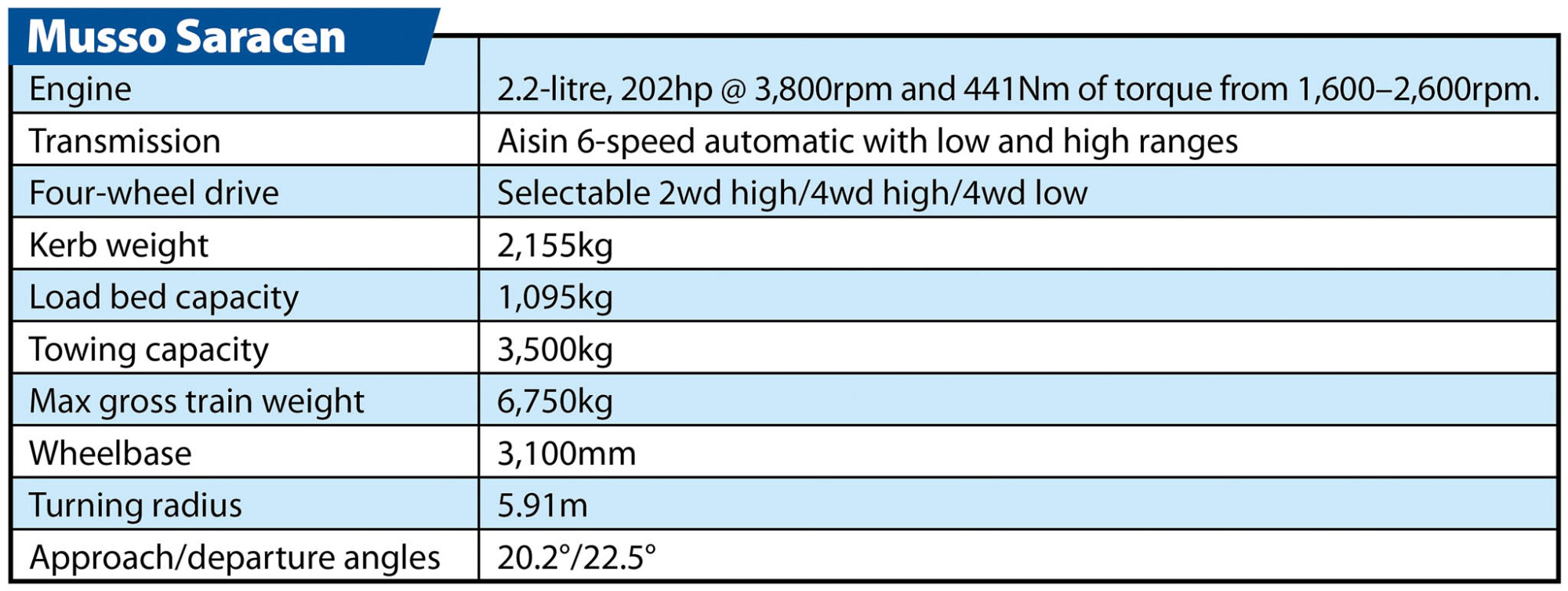
Performance and comfort
The large engine has plenty of power and the Musso handles loaded trailers on- and off-road easily. At 70mph on motorways it is quiet and there are no vibrations or rattles but, even without a load on board, slight inclines cause the transmission to shift down a gear to maintain constant speeds. The new Musso has double-wishbone front, and double-coil spring rear suspension and the set-up works well. Carrying heavy loads in the cargo bed, there is little body roll on corners and the vehicle feels secure. When empty, uneven surfaces are felt more by occupants, but the ride remains comfortable. The vehicle was driven across heavily rutted fields in wet conditions. There was adequate ground clearance and the Pirelli Scorpion 255/60R18 tyres maintained traction and steering control.
Overall, during the week-long test which included some longer journeys, the Musso achieved an impressive 36mpg fuel economy.
Maintenance
Routine oil level checks are easy to carry out with a dipstick near the front of the engine, and the windscreen wash filler is on the right-hand side and easily accessible. Service intervals are every 12,500 miles or 12 months, and Musso pick-ups come with a five-year, 100,000-mile warranty.
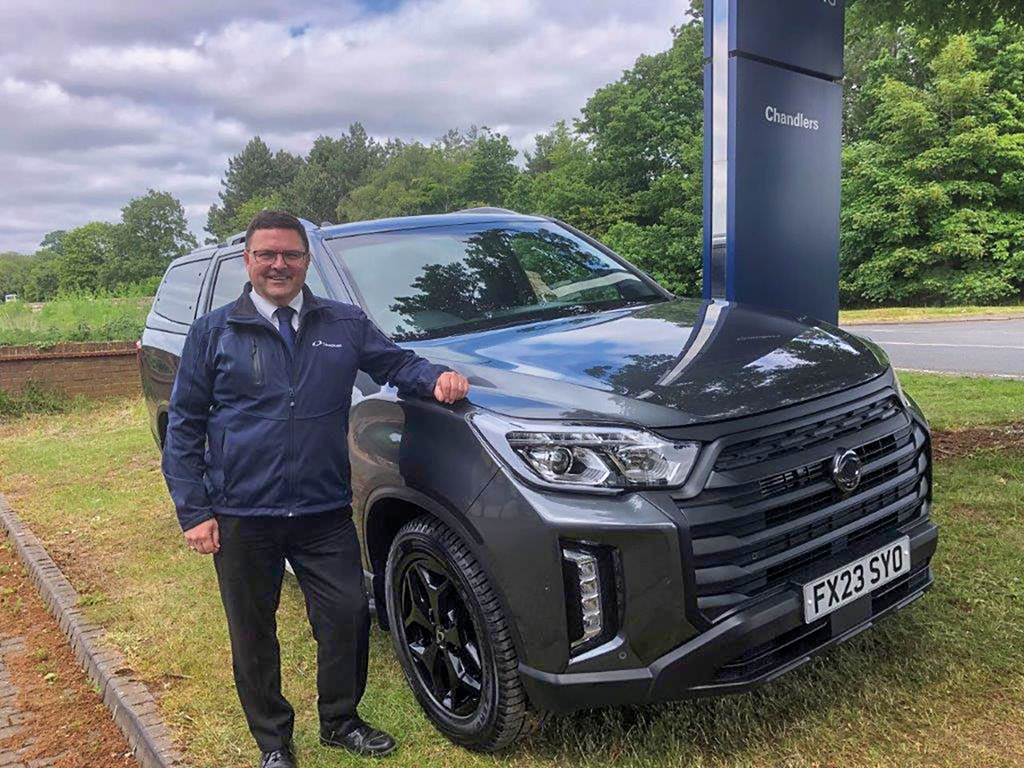
Chandlers dealer principal, Richard Young.
Verdict
The Musso Saracen has a quality finish and is extremely well equipped. The practical leather seats are an advantage over fabric upholstery in the base EX version, and the simulated leather of the Rebel model. Like other Musso pick-ups, the Saracen is an extremely capable load mover, and latest models also boast a comfortable cabin with space for adults in the front and rear. All-round visibility is very good through large windows separated by narrow pillars, and large rear-view mirrors.
Several large agricultural machinery dealers represent SsangYong and report high levels of satisfaction from farmer and contractor users. The Musso line-up starts at £25,140 (exc VAT) on the road for the EX, making the base model an attractive option for use around the farm and locally, while the Saracen tested costs from £32,540 but comes with useful additional features and extra comfort for family use and longer journeys.
Limited options for farms
During the past decade, the number of options in terms of 4×4 commercial-type vehicles suitable for farms has dwindled. Several panel van manufacturers offer 4wd as an option, but when it comes to vehicles with extra ground clearance and true off-road capability suitable for transporting tools and parts to machines broken down away from the yard there are few to choose from.
Premium solution
 The Defender commercial, designated Hard Top, is available in short (90) and long (110) wheelbase models and with a choice of engines. Both models are available in a range of equipment levels, starting with the base Hard Top, then the Hard Top S, SE, HSE, X-Dynamic HSE or X variants. The D250 power unit with 249hp and 570Nm of torque is fitted in Standard, S and SE variants, and the D300 engine with 300hp and a massive 650Nm of torque powers X-Dynamic HSE and X models. All engines are mild hybrid, which means they won’t run on a battery alone, but electric drive assistance during acceleration helps reduce fuel consumption and emissions.
The Defender commercial, designated Hard Top, is available in short (90) and long (110) wheelbase models and with a choice of engines. Both models are available in a range of equipment levels, starting with the base Hard Top, then the Hard Top S, SE, HSE, X-Dynamic HSE or X variants. The D250 power unit with 249hp and 570Nm of torque is fitted in Standard, S and SE variants, and the D300 engine with 300hp and a massive 650Nm of torque powers X-Dynamic HSE and X models. All engines are mild hybrid, which means they won’t run on a battery alone, but electric drive assistance during acceleration helps reduce fuel consumption and emissions.
Automatic eight=speed transmission with manual override is standard, and a mechanical two-speed transfer box provides a manually selected low range for extreme off-road situations.
The model supplied for the Farmers Guide test was the Defender 110 D250 in the mid-spec S trim level.
Land Rover Defender 110 Commercial D250
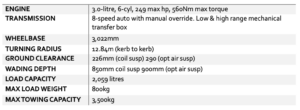
Practicality
A full-height mesh bulkhead behind the front seats ensures the driver, passengers and load remain separate even during heavy braking. The Hard Top version is based firmly on the standard model, but the rear windows are replaced by solid panels, the rear seats have been removed and replaced by a full-length, flat floor, and space that would have accommodated the passengers’ legs has been cleverly converted to underfloor storage.
The long wheelbase (five-door) version tested retains its two rear passenger side doors, and these add convenience for loading.
Total load volume is impressive, at 2,059 litres. The lockable storage under the floor adds 58 litres just inside the rear door, and 155 litres behind the front seats. Opening the rear side doors exposes horizontal hatches which provide access to the underfloor storage even when the load area floor is completely covered.
Access to the rear load area is less convenient than it would be for a large panel van, as the doors were shaped for passenger use rather than for loading bulky items.
The rear door is 90cm high, and the opening width is between 96 and 106cm. The single-piece door has side hinges and opens easily. The side hinged opening means it is easy to stand at the rear and reach loads inside by hand, or using a forklift, but opening the door fully requires a lot of clearance.
With standard coil spring suspension the ride height is fixed, and the load floor is 83cm above ground level at the rear, and 92cm through the side doors.
The internal load area is 147cm long, and 146cm wide just behind the bulkhead at floor level, increasing to 152cm wide higher up, At the rear, just inside the rear door the usable width is 111cm.
There are four hefty tie-down points.
Towing capacity is 3,500kg, even with the maximum 818kg payload.
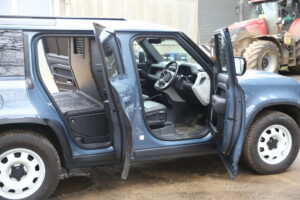
The test vehicle was equipped with an optional third centre seat. Space is tight when transporting three adults, but it is reasonably comfortable for shorter journeys.
Comfort and controls
The Defender Hard Top comes standard with just two front seats, but the test vehicle also had the optional third seat between the two standard seats. The seats are all comfortable, although the centre seat is slightly higher. When carrying three adults the cab is quite cosy, and the huge number of grab handles is a help when travelling over uneven ground. For shorter journeys the accommodation is adequate, and being able to occasionally carry three people will be an advantage for most farms and contracting businesses. When the centre seat isn’t needed it can be folded to create a flat space suitable for resting a laptop, and it also contains two large cup holders. It is a very practical design.
Like passenger versions, all the main controls are dashboard mounted – including the gear selector. Gear lever positions in auto mode are Reverse, Neutral, Drive and Park. Manual gear shifting is available by pushing the gear stick to the left and then pushing it forward or pulling it back. There are no steering wheel paddles.
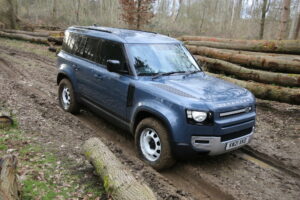
Heavily rutted woodland tracks and muddy fields were no problem for the capable off-roader.
Superb off-road
All Defenders come with Terrain Response. This allows the driver to select drive characteristics to match the terrain using a rotary dial which doubles as the driver’s side temperature control. Options include Eco, Comfort, Grass/gravel/snow, Mud ruts, Sand and Rock Crawl. A separate button selects low range which reduces the gear ratios considerably, but the vehicle must be stationary.
The test week included an opportunity to try the Defender in demanding off-road conditions in woodland. Forestry machinery had created deep ruts, and the heavy, wet ground was extremely slippery. Even so, the Defender coped perfectly well in the standard road driving modes, although when the Mud ruts mode was selected there was noticeably more traction as the differentials locked, and the vehicle felt more capable. The powerful engine was superb – and the huge amount of torque produced meant that the Defender maintained constant low speeds as conditions varied easily, at just over an idle.
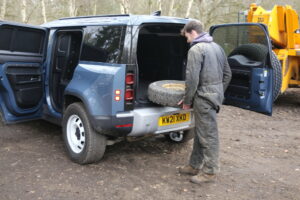
The Defender 110 Hard Top is ideal for transporting tools and equipment around the farm but has a high price tag.
Performance and handling
On the road, the large Defender also handles well. The suspension is very firm but comfortable and there is little body roll when cornering. The big engine is smooth and exceptionally quiet, and there is very little wind noise contributing to a high level of comfort during longer journeys.
Official acceleration figures include a 0–60mph time of just 7.9 seconds, and a maximum speed of 117mph.
The test week included a wide range of driving situations from motorway use to the woodland tracks, and average fuel consumption was 28.5mpg. Where permitted – 70mph is achieved at approximately 1,500rpm, and on a longer journey the Defender achieved almost 38mpg.
Ease of use
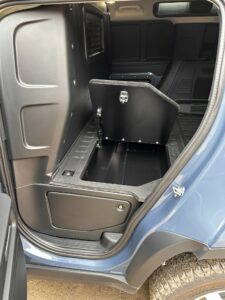 All-around vision is excellent. The external mirrors provide a clear view down the sides, and the test vehicle also had the optional ClearSight internal mirror. The view through a conventional mirror would be partially obstructed by the full-height mesh bulkhead as well as loads in the rear, but the ClearSight mirror is a screen which displays an image from a camera at the back of the vehicle. It works well and improves safety when manoeuvring in tight spaces. The S-specification also includes a 3d surround view displayed on the dashboard screen. This highlights obstructions close to the car and contributes to safe manoeuvring.
All-around vision is excellent. The external mirrors provide a clear view down the sides, and the test vehicle also had the optional ClearSight internal mirror. The view through a conventional mirror would be partially obstructed by the full-height mesh bulkhead as well as loads in the rear, but the ClearSight mirror is a screen which displays an image from a camera at the back of the vehicle. It works well and improves safety when manoeuvring in tight spaces. The S-specification also includes a 3d surround view displayed on the dashboard screen. This highlights obstructions close to the car and contributes to safe manoeuvring.
The 10in touchscreen is clear and easy to use. The menus are logical, and it takes little time to get used to the functions. Apple CarPlay and Android Auto compatibility is standard. The navigation system is the same as in standard passenger variants and it is easy to set up and use.
All new Defenders come with plenty of storage for odds and ends. This includes large door pockets, trays of various sizes in the dashboard, plus a reasonable size glovebox.
Land Rover Defender Commercial: The verdict
For those needing a commercial vehicle that can carry up to three passengers in comfort, perform exceptionally well off-road, and pull large trailers, the Defender 110 D250 Hard Top is hard to beat. However, the attractive package comes with a relatively high price tag. The standard model costs approximately £47,450 + VAT and upgrading to the S specification tested adds approximately £2,860 + VAT. Additional options fitted to the test car included an electric folding towbar, the ClearView rear mirror, a Tracker, an electronic active differential, the centre front seat, metallic blue paint and off-road tyres which added a further £4,500.
The Discovery Sport joined the Land Rover line-up in 2014 when it replaced the Freelander. It remains extremely popular and that is probably because although it is smaller, easier to drive around town and park, and boasts more stylish lines than the full-size Discovery or the latest Defender, it still has the character and feel of a proper Land Rover. David Williams tried the latest version.
The model provided for the Farmers Guide week-long test was the Discovery Sport R-Dynamic SE with a D200 power unit.
The model line-up features the Discovery Sport as the base version. This comes with a 165hp diesel engine and 2wd, or with the same engine and permanent 4wd in mild hybrid form. The mild hybrid MHEV system stores energy during deceleration and when travelling downhill, then uses the electrical power to assist the diesel engine during acceleration to save fuel and reduce emissions.
The Discovery Sport R-Dynamic comes in permanent 4wd form only, and in SE or better equipped HSE variants. The SE includes a choice of four engines including the D165 – a 165hp diesel with MHEV, as well as the D200 204hp diesel with MHEV, a P250 249hp petrol with MHEV and the most powerful P300e petrol/plug-in hybrid with 309hp.
There are also two ‘Edition’ models – the Discovery Sport Urban and Discovery Sport Black. The Sport Urban has a choice of the D165, D200 or P300e power units and the Sport Black is available only with a P290 290hp petrol engine.
The Discovery Sport R-Dynamic SE we tested comes with a generous standard specification, and the option of five or seven seats.
Interior and comfort
The seats are comfortable, with adequate legroom for a tall driver and front seat passenger. The driver’s seat has 12-way adjustment which makes it easy to achieve a comfortable driving position and once it is set the seat position can be stored within a driver profile for recall at the touch of a button. The Discovery Sport is more compact than the full-size Discovery and with the front seats right back, there is limited leg room in the second-row seats. Moving the front seats forward only slightly makes a big difference to the leg space in the rear, and four adults can undertake long journeys in comfort.
The test vehicle had optional third row seats. When these aren’t needed they fold under the rear load area leaving an almost flat floor, but for use they fold out in seconds complete with full three-point retractable seat belts. Getting into the third row involves tilting the second-row seats forward and entering through either of the two rear doors. The rear-most seats are very shallow and close to the floor making them best suited to use by children. However, making best use of available space in a vehicle is always a compromise, and if the ability to transport seven people safely is needed, then the Discovery Sport provides a practical solution.
The interior is smart but functional. The steering wheel is chunky, and the integral switches are easy to use.
Friendly design
The 10in touchscreen display is easy to use. The driver can select a full-screen display for navigation or divide the screen into sections so that a reduced size map, telephone and media are all displayed simultaneously. The sat-nav system is good and menus are logical and intuitive, so it takes little time to get used to them.
The view through the windscreen and large side windows is good, and the external mirrors are well positioned to negotiate narrow gaps and tight gateways. A 360-degree camera displays an outline image of the car on the centre display along with any objects nearby and, when reverse is selected, there is a clear image from the rear camera on the screen.
The R-Design SE comes with a fixed full-length panoramic glass roof. An internal blind operates electrically, and when it is retracted the interior is a lot brighter and the car feels more spacious.

There is plenty of room for four or five adults to travel in comfort. The test vehicle was a seven-seat version with two additional seats in the rear, but limited leg space means they are better suited to transporting children.
Practicality
With the third-row seats folded away there is a reasonable load area, and this can be further extended by folding the second-row seats forward. The load space is almost flat making it suitable for large, heavy items and there are strong tie-down points to secure loads. The one-piece rear door is hinged at the top. This makes it easy to reach deep inside the boot to place or remove heavy items, but it is more difficult to open the door where space is limited.
There is plenty of storage, including large pockets in the front and rear doors. The glovebox is shallow, but there is a storage box with a lid in the centre console, a large open storage compartment in front of the gear selector and two large drinks holders also in the centre.
Second and third row seat occupants also have drinks holders.
The test vehicle didn’t have a tow bar but judging by the performance on hilly terrain the D200 power unit will easily handle trailers up to the 2,200kg maximum. Trailer stability assist is standard.
Other practical features include puddle lights that assist while entering and exiting the car in the dark, power folding external mirrors with automatic dimming on the driver’s side and Blind Spot Assist which displays a subtle but clear warning in the mirrors if a car or other object is in the blind spot beside the vehicle.
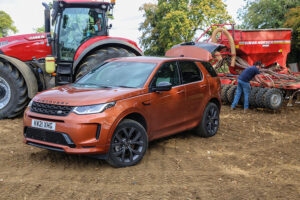
The Discovery Sport is a roomy and comfortable family car, but impressive off-road capability including plenty of ground clearance means it will also transport people and equipment around the farm when other 4×4 vehicles aren’t available.
Performance and handling
The D200 engine is smooth and quiet. On the road, the Discovery Sport cruises easily at 70mph, and there is plenty of acceleration to pull away briskly from junctions in heavy traffic. Most of the time, the nine-speed automatic gearbox changes so smoothly that the gear shifts are not noticeable except under rapid acceleration, but in some situations when changing speeds frequently in heavy traffic, a new gear is selected and the drive re-engages with a jolt.
Selecting manual gear shifting instead of auto is achieved by pushing the gear selector to the left. Moving the lever backwards and forwards changes up and down through the gears, or the gear selector paddles behind the steering wheel can be used instead. Returning the lever to the right position re-selects automatic mode. There is also a temporary manual override function. Operating the steering wheel paddles selects manual mode with manual shifting for a limited time after which automatic mode resumes.
The week-long test included a mix of long motorway journeys as well as travel on narrow rural roads and rough farm tracks, and the flexible engine and transmission performed well.
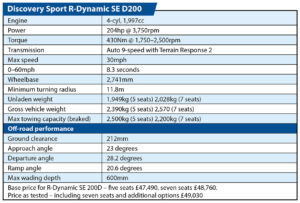
Farmers Guide put Land Rover’s Discovery Sport through its paces on- and off-road during a
week-long test.
Adapts to terrain
The Discovery Sport comes with Terrain Response 2, which constantly monitors the driving conditions and terrain and configures the engine and transmission to suit. Although the system is extremely capable, there is also the option to select the driving mode manually. Settings include Comfort; Dynamic; Eco; Grass/Gravel/Snow; Mud & Ruts; Sand and Wade sensing. Most of the time we had Eco mode selected which was adequate in almost every situation but selecting the soft sand setting when driving across freshly cultivated ground meant lower gears were selected with higher engine revs, and the vehicle became more responsive.
Additional driver assistance features include All Terrain Progress Control, Hill Descent Control and Hill Launch Assist, although the car is so capable that for most situations the standard automatic settings are adequate.
It is a very easy car to drive and it feels compact and nippy on narrow, winding roads. The ride quality is good and there is little roll on corners. The suspension is firm but comfortable and it copes well travelling along pot-holed back roads and rutted farm tracks at speed. The tyre equipment was standard for this model and version, and the Pirelli All-Season 235/50R20s were quiet and gripped well on and off road.
Overall, during the test week, the Discovery Sport achieved 39.8mpg average fuel consumption, and on a longer motorway journey it exceeded 43mpg.
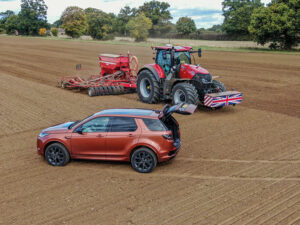
The test vehicle had Land Rover’s D200 diesel engine which develops 204hp and 430Nm of torque between 1,750–2,500rpm. This is probably the best choice for farm use as there is plenty of power for relaxed towing, but it remains surprisingly economical.
Land Rover Discovery Sport R-Dynamic SE: The verdict
The Discovery Sport is unlikely to be chosen as the main farm transport vehicle. It lacks the rugged practicality, capacity or towing ability of a typical farm pick-up or the bigger Land Rover Defender or Discovery models. However, it is extremely capable off-road, and its ability to carry loads and tow trailers across wet, slippery grassland, handle deep rutted tracks and cross field edge plough furrows means it can contribute to farm transport activities when other vehicles aren’t available.
It’s a large and comfortable car which is suitable for transporting a farm or contracting team between work locations, doing the school run or taking families on longer journeys – although the third-row seats lack the leg room needed for adults. Folding the second-row seats forward creates a large, flat load area capable of transporting parts and equipment.
The Discovery Sport performs well on the road, and as the Farmers Guide test demonstrated, the D200 version – which seems the best option for farm use, returns impressively good fuel consumption. The HSE upgrade comes in at just under £2,500 more than the SE, and that adds front fog lights, an improved sound system, 14-way electric driver seat adjustment, an adjustable rear seat and Configurable Dynamics which allows aspects of the car’s handling including steering and suspension to be adjusted to suit the driver’s preference.
The car has a chunky feel, it is ruggedly made and, although it is at the lower end of Land Rover’s line-up, it remains worthy of the badge.
